The Canadian Militia (1879)
Topic: Canadian Militia

The Canadian Militia (1879)
The Montreal Gazette, 4 March 1879
 The remarks of Lieutenant-General Sir Selby-Smith, in his annual report, on the necessity of an organized force which could always be depended on in case of such disturbances as those of which the country has recently has experience, are worthy of careful attention. The inconvenience of employing volunteers for the purpose of quelling riots in which their own fellow-citizens are the actors has often been felt; and we have not to go far in either space or time for illustrations of some of the bad results of the system. The formation of a small permanent force such as that which General Smyth suggests would remove that inconvenience and make the repression of disorder practicable without the risk of provoking complications that are the most difficult to deal with. As to the plan on which such a force should be raised, General Smyth has certainly quite sufficient military knowledge and experience, and well as acquaintance with the needs and capabilities of the Dominion, to enable him to frame one in every way suitable. It will have been seen that he proposes that three regiments should be maintained by the Federal Government, composed of two battalions each, to be raised and recruited in Canada, each battalion to serve in the old country and here for alternate terms of three years, thus completing their period of enlistment, which should be fixed at six years. At the close of their six years' service the men composing the battalions should pass into a reserve and receive a grant of land or some other inducement to settle permanently in the country, with a stake in it. By this system of alternation and interchange, complete solidarity would be established between the soldiers of Canada and that of the Empire, and our little Canadian force have full opportunity for thorough training, and be imbued with a British spirit. In case of war the system would be capable of expansion to any limits required. Another scheme proposed was that only three Canadian battalions should be formed, whioch should be interchanged triennially with an equal British force of the line. Hitherto, it appears that nothing has been done towards giving either suggestion a practical form, but it is hoped that the matter will not be lost sight of. Of course, the carrying out of such a plan would not interfere materially with our Canadian militia, as at present organized and composed. It would be from the militia that, in all likelihood, such a force would be, to a great extent, supplied and on it also it would have to mainly depend for the enlargement which extraordinary contingencies might necessitate. The value of such a force may be inferred from what general Selby-Smyth says in another part of his report regarding the probable effect of the muster of volunteers is this city last Queen's Birthday on the Fenian raiders who were at that time rumoured to be about to cross the line into Canada. He thinks, and with good reason, that there were Fenian spies present on that occasion and that the sight of so large a body of well trained and well equipped soldiers, whom they would have to encounter, if they attempted to put their project into execution, had a salutary influence in deterring them from the menaced movement. How much more would such disturbers be cowed into tranquility is a permanent force, always armed and prepared to meet invasion, were maintained in the Dominion! In a short time we should probably be put to no more trouble or expense (and such occasions have cost us our share of both) from such unscrupulous free booters.
The remarks of Lieutenant-General Sir Selby-Smith, in his annual report, on the necessity of an organized force which could always be depended on in case of such disturbances as those of which the country has recently has experience, are worthy of careful attention. The inconvenience of employing volunteers for the purpose of quelling riots in which their own fellow-citizens are the actors has often been felt; and we have not to go far in either space or time for illustrations of some of the bad results of the system. The formation of a small permanent force such as that which General Smyth suggests would remove that inconvenience and make the repression of disorder practicable without the risk of provoking complications that are the most difficult to deal with. As to the plan on which such a force should be raised, General Smyth has certainly quite sufficient military knowledge and experience, and well as acquaintance with the needs and capabilities of the Dominion, to enable him to frame one in every way suitable. It will have been seen that he proposes that three regiments should be maintained by the Federal Government, composed of two battalions each, to be raised and recruited in Canada, each battalion to serve in the old country and here for alternate terms of three years, thus completing their period of enlistment, which should be fixed at six years. At the close of their six years' service the men composing the battalions should pass into a reserve and receive a grant of land or some other inducement to settle permanently in the country, with a stake in it. By this system of alternation and interchange, complete solidarity would be established between the soldiers of Canada and that of the Empire, and our little Canadian force have full opportunity for thorough training, and be imbued with a British spirit. In case of war the system would be capable of expansion to any limits required. Another scheme proposed was that only three Canadian battalions should be formed, whioch should be interchanged triennially with an equal British force of the line. Hitherto, it appears that nothing has been done towards giving either suggestion a practical form, but it is hoped that the matter will not be lost sight of. Of course, the carrying out of such a plan would not interfere materially with our Canadian militia, as at present organized and composed. It would be from the militia that, in all likelihood, such a force would be, to a great extent, supplied and on it also it would have to mainly depend for the enlargement which extraordinary contingencies might necessitate. The value of such a force may be inferred from what general Selby-Smyth says in another part of his report regarding the probable effect of the muster of volunteers is this city last Queen's Birthday on the Fenian raiders who were at that time rumoured to be about to cross the line into Canada. He thinks, and with good reason, that there were Fenian spies present on that occasion and that the sight of so large a body of well trained and well equipped soldiers, whom they would have to encounter, if they attempted to put their project into execution, had a salutary influence in deterring them from the menaced movement. How much more would such disturbers be cowed into tranquility is a permanent force, always armed and prepared to meet invasion, were maintained in the Dominion! In a short time we should probably be put to no more trouble or expense (and such occasions have cost us our share of both) from such unscrupulous free booters.
The report goes on to make some excellent suggestions as to the proper administration of the militia force. It is to be noted that some of these suggestions merely call for the enforcement of the existing laws on the subject—a telling commentary on the manner in which it has been hitherto neglected. We do not intend just now to take them all into consideration, but we have no dough that they will receive from the proper authorities the attention which is their due. Of […missing line of text…] Corporation of Montreal—that which regards the rebuilding of the drill shed. It is advised that the Government should urge on our Municipal Council the duty of re-construction or, in the case of refusal or neglect, due for the value at stake, $12,000. This is a matter which demands immediate settlement, and it is hoped it will be arrived at with as little delay as possible. Both this and several others of the suggestions to which we direct attention have already been made to no purpose. It is evident from them and from the whole tenor of the report that our militia force has, up to the present, by no means received the attention of which such a force in a country of the extent, population and position of Canada is worthy.
In a paper contributed to the February number of Rose-Belford's Magazine, entitled "A Plea for the Militia," by "Two Militiamen," the whole case is very clearly and patriotically stated. After speaking of our national pride, our great extant and resources, and our growing importance, the writers very opportunely ask how we should maintain our rights, protect our liberties and retain our possessions, if Great Britain's naval and military assistance were withheld or withdrawn. They then very pointedly contrast our position from a military standpoint with some of the smaller European powers, giving a result which is far from flattering to our self-love. The Netherlands, with a population of less than 4,000,000, expend for military purposes £1,541,909, have an army of 61,947 men, a navy of 47 ships, with 705 guns, manned by 9,200 men, and a militia of 100,323 men. Switzerland, with a population of less than 3,000,000, expends £586,237, has an army of 84,369 men, a reserve of 50,069 men, and a militia force of 65,981 men. Sweden, with a population of less than 4,500,000, expends £925,000, has an army of 7,885 men and a reserve force of nearly 140,000 men. Norway, with a population of less than 2,000,000, has an army of 12,750 (peace footing), and of 18,000 (war footing), 20 ships of war, with 156 guns, manned by 2,393 men, and a reserve of 62,000. Denmark, with a population of less than 2,000,000, expends £1,114,000, has an army of 37,000 men, 33 ships, with 291 guns, manned by 1,125 men and a reserve of 32,393. Greece, with a population of less than a million and a half, expends £336,757, has an army of 14,061 men, a navy of 14 ships, manned by 653 men, and a reserve of 24,000. Canada, with nearly 4,000,000 of population, has only a poorly equipped militia force of 43,729, of which she expends only £200,000. These figures speak for themselves, and almost make unnecessary the excellent argument which follows, by which the plea is so well supported. Let any Canadian compare Canada with the Netherlands or with Denmark, and he will appreciate the motive of these two loyal militiamen in presenting their plea. Again, "in Great Britain the people are taxed $6.86 per head per annum; in France $4.50; in Prussia, $2.20; and in the United States (exclusive of the State militia) $1.39 per head, while in Canada we only burden ourselves with 14 cents per head of our population for militia purposes."
Most readers will agree with the writers that no "Canadian would object to that tax being doubled or quadrupled." To the question why a militia should be supported which in peace is not required, and in war would be inadequate as a protection against invasion, "Two militiamen" answer by an appeal to history. They recapitulate the services of the Canadian militia from 1775, when Quebec was held by it against the enemy till the arrival of British reinforcements, until the occurrence of the riots of the last few years. In 1812, 1813, in 1837, in 1862, in 1865, in 1866-70, what would the country have done had there been no militia to repel such attacks? "Two militiamen" then deal with the question as to what principle will render the force most efficient at least cost, and come to the conclusion that the nearest approach to our system, as defined by law, is the Danish system. Having glanced at its working and results and given a brief sketch of the Swiss system, they ask, "What are we to do towards the same end?" To this they reply that "no hurried extension of the present system is necessary or would be prudent." "But," they add, "the framework must be built in time of peace, upon such solid foundation that it will neither shrink nor give war under pressure of war." Sufficient funds must be provided to carry on the work regularly, and the vote should be a standing sum, not subject to legislative caprice. Once the country has decided what it can afford to spend annually, let those persons who are held responsible for the efficiency of the force be held responsible for its proper expenditure. After showing that there is no object for which the people at large are more willing to submit to outlay, and that there is no money so evenly distributed through the country as the money paid to the militia, the article closes with an appeal to the community to conquer the the apathy with which the past struggles for existence of the militia force have been regarded. And this appeal is accompanied by the warning that, if the present force is discouraged to death, the law providing for the establishment of the ballot must be executed and, instead of employees, employers may be pressed into the ranks. All that is asked is that the provisions of the militia law be slightly emended and rigidly enforced, that a little more money be spent in the actual training of the men, and that the Canadian people take a living interest and pride in their citizen soldiery and encourage them by precept and example, stimulating rather than retarding their efforts to fulfill their duty.

Posted by regimentalrogue
at 12:01 AM EST

 January 29th is the anniversary of the institution of the soldiers most precious decoration—perhaps the most precious decoration in the world—the Victoria Cross, for it was instituted by Her Majesty, the late Queen Victoria, on the 26th day of January, 1856, and so is not quite 50 years old. While it is the most prized of all the decorations and orders an Englishman can win, it is also the most democratic decoration in the world, although it is the official badge of an actual personal courage and daring, it has no concern with rank, long service or wounds, and it may be worn by one who has been only a few months, or even weeks, in the army, while other who have spent their lives in the service and gained rank and other decorations may not possess it.
January 29th is the anniversary of the institution of the soldiers most precious decoration—perhaps the most precious decoration in the world—the Victoria Cross, for it was instituted by Her Majesty, the late Queen Victoria, on the 26th day of January, 1856, and so is not quite 50 years old. While it is the most prized of all the decorations and orders an Englishman can win, it is also the most democratic decoration in the world, although it is the official badge of an actual personal courage and daring, it has no concern with rank, long service or wounds, and it may be worn by one who has been only a few months, or even weeks, in the army, while other who have spent their lives in the service and gained rank and other decorations may not possess it.




 The remarks of Lieutenant-General Sir Selby-Smith, in his annual report, on the necessity of an organized force which could always be depended on in case of such disturbances as those of which the country has recently has experience, are worthy of careful attention. The inconvenience of employing volunteers for the purpose of quelling riots in which their own fellow-citizens are the actors has often been felt; and we have not to go far in either space or time for illustrations of some of the bad results of the system. The formation of a small permanent force such as that which General Smyth suggests would remove that inconvenience and make the repression of disorder practicable without the risk of provoking complications that are the most difficult to deal with. As to the plan on which such a force should be raised, General Smyth has certainly quite sufficient military knowledge and experience, and well as acquaintance with the needs and capabilities of the Dominion, to enable him to frame one in every way suitable. It will have been seen that he proposes that three regiments should be maintained by the Federal Government, composed of two battalions each, to be raised and recruited in Canada, each battalion to serve in the old country and here for alternate terms of three years, thus completing their period of enlistment, which should be fixed at six years. At the close of their six years' service the men composing the battalions should pass into a reserve and receive a grant of land or some other inducement to settle permanently in the country, with a stake in it. By this system of alternation and interchange, complete solidarity would be established between the soldiers of Canada and that of the Empire, and our little Canadian force have full opportunity for thorough training, and be imbued with a British spirit. In case of war the system would be capable of expansion to any limits required. Another scheme proposed was that only three Canadian battalions should be formed, whioch should be interchanged triennially with an equal British force of the line. Hitherto, it appears that nothing has been done towards giving either suggestion a practical form, but it is hoped that the matter will not be lost sight of. Of course, the carrying out of such a plan would not interfere materially with our Canadian militia, as at present organized and composed. It would be from the militia that, in all likelihood, such a force would be, to a great extent, supplied and on it also it would have to mainly depend for the enlargement which extraordinary contingencies might necessitate. The value of such a force may be inferred from what general Selby-Smyth says in another part of his report regarding the probable effect of the muster of volunteers is this city last Queen's Birthday on the Fenian raiders who were at that time rumoured to be about to cross the line into Canada. He thinks, and with good reason, that there were Fenian spies present on that occasion and that the sight of so large a body of well trained and well equipped soldiers, whom they would have to encounter, if they attempted to put their project into execution, had a salutary influence in deterring them from the menaced movement. How much more would such disturbers be cowed into tranquility is a permanent force, always armed and prepared to meet invasion, were maintained in the Dominion! In a short time we should probably be put to no more trouble or expense (and such occasions have cost us our share of both) from such unscrupulous free booters.
The remarks of Lieutenant-General Sir Selby-Smith, in his annual report, on the necessity of an organized force which could always be depended on in case of such disturbances as those of which the country has recently has experience, are worthy of careful attention. The inconvenience of employing volunteers for the purpose of quelling riots in which their own fellow-citizens are the actors has often been felt; and we have not to go far in either space or time for illustrations of some of the bad results of the system. The formation of a small permanent force such as that which General Smyth suggests would remove that inconvenience and make the repression of disorder practicable without the risk of provoking complications that are the most difficult to deal with. As to the plan on which such a force should be raised, General Smyth has certainly quite sufficient military knowledge and experience, and well as acquaintance with the needs and capabilities of the Dominion, to enable him to frame one in every way suitable. It will have been seen that he proposes that three regiments should be maintained by the Federal Government, composed of two battalions each, to be raised and recruited in Canada, each battalion to serve in the old country and here for alternate terms of three years, thus completing their period of enlistment, which should be fixed at six years. At the close of their six years' service the men composing the battalions should pass into a reserve and receive a grant of land or some other inducement to settle permanently in the country, with a stake in it. By this system of alternation and interchange, complete solidarity would be established between the soldiers of Canada and that of the Empire, and our little Canadian force have full opportunity for thorough training, and be imbued with a British spirit. In case of war the system would be capable of expansion to any limits required. Another scheme proposed was that only three Canadian battalions should be formed, whioch should be interchanged triennially with an equal British force of the line. Hitherto, it appears that nothing has been done towards giving either suggestion a practical form, but it is hoped that the matter will not be lost sight of. Of course, the carrying out of such a plan would not interfere materially with our Canadian militia, as at present organized and composed. It would be from the militia that, in all likelihood, such a force would be, to a great extent, supplied and on it also it would have to mainly depend for the enlargement which extraordinary contingencies might necessitate. The value of such a force may be inferred from what general Selby-Smyth says in another part of his report regarding the probable effect of the muster of volunteers is this city last Queen's Birthday on the Fenian raiders who were at that time rumoured to be about to cross the line into Canada. He thinks, and with good reason, that there were Fenian spies present on that occasion and that the sight of so large a body of well trained and well equipped soldiers, whom they would have to encounter, if they attempted to put their project into execution, had a salutary influence in deterring them from the menaced movement. How much more would such disturbers be cowed into tranquility is a permanent force, always armed and prepared to meet invasion, were maintained in the Dominion! In a short time we should probably be put to no more trouble or expense (and such occasions have cost us our share of both) from such unscrupulous free booters.

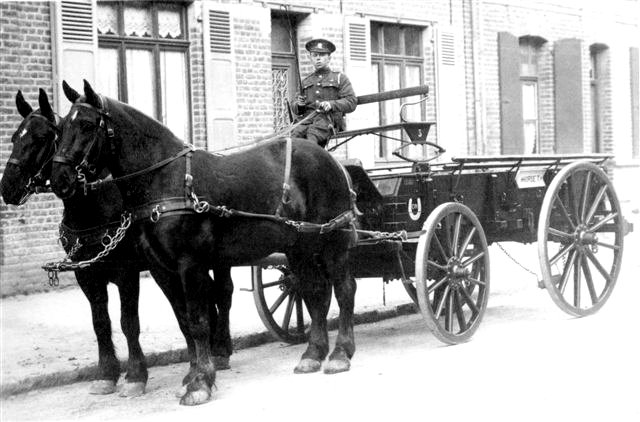

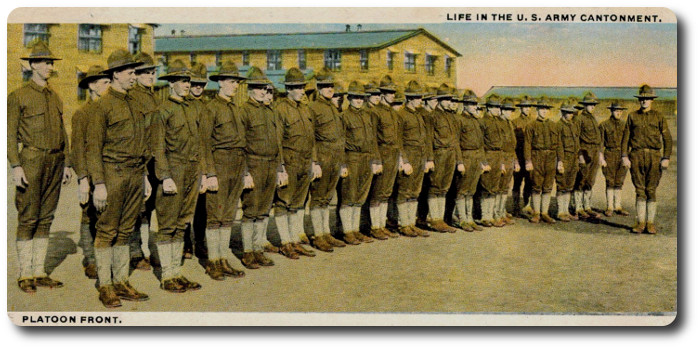
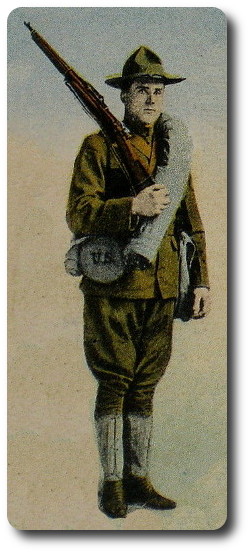 Each soldier in a modern army carries with him sufficient food, clothing, shelter, fighting arms and ammunition to take care of himself for a short period in case he should be separated from his company. The total weight of his load, in addition to the clothes he wears, is 50 to 70 pounds. The number of articles is surprisingly large. They are so devised, however, that by ingenious methods of packing and adjusting they can all be carried with the least possible effort.
Each soldier in a modern army carries with him sufficient food, clothing, shelter, fighting arms and ammunition to take care of himself for a short period in case he should be separated from his company. The total weight of his load, in addition to the clothes he wears, is 50 to 70 pounds. The number of articles is surprisingly large. They are so devised, however, that by ingenious methods of packing and adjusting they can all be carried with the least possible effort.

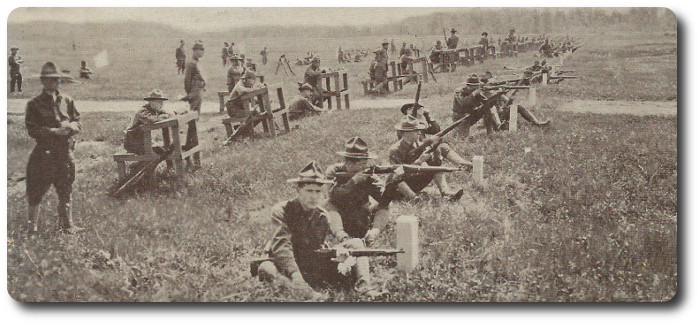

 His Excellency the Commander in Chief has been pleased to direct that Captain Hanson's Company, No. 1, of the
His Excellency the Commander in Chief has been pleased to direct that Captain Hanson's Company, No. 1, of the 
 Militia General Orders
Militia General Orders


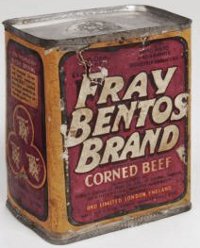 Frozen meat at present constitutes 60 per cent of the total meat issued to the British army. The remainder is made up of preserved meat of several varieties. The most familiar form is the well-known "bully beef," which is corned beef packed in small oblong tins, each containing 12 ounces. Some units cook their bully beef, other prefer it just as it comes from the tin. In comprised the principal article of diet for the army at Gallipoli.
Frozen meat at present constitutes 60 per cent of the total meat issued to the British army. The remainder is made up of preserved meat of several varieties. The most familiar form is the well-known "bully beef," which is corned beef packed in small oblong tins, each containing 12 ounces. Some units cook their bully beef, other prefer it just as it comes from the tin. In comprised the principal article of diet for the army at Gallipoli.

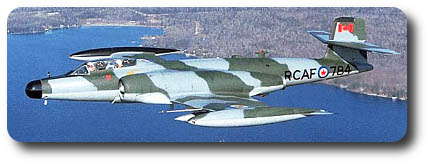 The entire Canadian air defence potential, excluding only a division of jet interceptors stations in Europe, is in process of being put under the operational control of the North American Air Defence Command at Colorado Springs, along with USAF jets.
The entire Canadian air defence potential, excluding only a division of jet interceptors stations in Europe, is in process of being put under the operational control of the North American Air Defence Command at Colorado Springs, along with USAF jets.




 Mr. Harkness then referred to the three weapons systems coming into service with the armed forces as all having a nuclear capability. These were the Honest John rocket launcher for the army, the Bomarc anti-aircraft weapon for the RCAF at home, and the CF-104 jet strike-attack plane for the air force in Europe.
Mr. Harkness then referred to the three weapons systems coming into service with the armed forces as all having a nuclear capability. These were the Honest John rocket launcher for the army, the Bomarc anti-aircraft weapon for the RCAF at home, and the CF-104 jet strike-attack plane for the air force in Europe.
